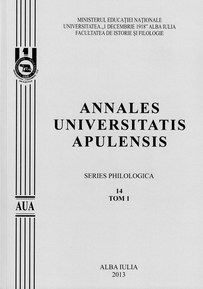Afixe olteneşti
Oltenian Affixes
Author(s): Ana-Maria DudăuSubject(s): Language and Literature Studies
Published by: Universitatea »1 Decembrie 1918« Alba Iulia
Keywords: Oltenian subdialect; suffix, prefixed formations, basic lexical unit, deprefixation, meaning, composition, archaic note
Summary/Abstract: If, during the evolution of language (including its morphematic structure), some affixes have deeply rooted in it, contributing to the formation of a number of viable derivatives, others, however, gradually lose their former derivative potentialities. To indicate that an affix is unproductive nowadays we must analyse the derivational potencies which that affix proved in the past, the degree of viability of derivatives in the mother tongue (the amount of derivatives that were maintained in an active vocabulary and the number of those who have applied in passive reserve) and the productivity of the affix manifested today, i.e. the number of new attestations in the speech. There is preference for certain suffixes in Oltenian sub-dialects. One of these [ete] is used in different words that we have found in the studied texts. The nouns in-eţ or-et (suffixes or final endings) have created new forms in „-ete” (productive suffix, which could then add to other roots). Obviously, the singular forms in-ete were born under the influence of a plural in-eţ. Examples: „căpete capacity measure, copilete vineyard offshoot” (ALR I, s.n., h. 103 and Gîlcescu, Gorj), burfete, hârlete, prunete. Another suffix to be considered is-iş (with variant -îş) an affix forming modal adverbs from nouns and verbs (it was very productive, especially in 16th-17th century). Some of its derivatives, however, lost their degree of viability in the contemporary Romanian language, being only in the structure of phraseological words: o apucă brăţiş (took her by the arm), mergeau ponciş (they walked slantwise), gâlgâie oraşu lungiş (the town is cackling far and wide), mergea lăturiş (they walked lengthwise). A specific suffix to antroponyms with great frequency in Oltenia (one might add here, in part, and the Banat Chesnoiu, Popoiu, Ilioniu, Văcăroniu.), is-oi (-oiu, -ońu-, with softened preserved from LAT.-oneus): Huzoi, Humoiu, Filipoiu, Ghiţoiu. The plural of collective names, of social group, ń is a constant: the Brancusonies, the Cojocaronies, the Vladonies, the Cioranies etc. The conservation of ń from the phonetic structure of the suffix, lends an archaic note to the Northern Oltenian sub-dialect. The examples we have given here are retained from the literary texts under analysis. Carrying out a hierarchy of prefixes, depending on their productivity and frequency of recording prefixed words, we notice that in the first place, both in old and present-day Romanian language, is placed the prefix -ne (non). The great productivity of this prefix is explained by the fact that it is a very simple way to express the opposite notion, in relation to that contained in the lexical unit-base. It is to note, as C. Noica mentions, „the capacity of the prefix to make words, even to do whatever it likes, as was, in our alive speech.
Journal: Annales Universitatis Apulensis. Series Philologica
- Issue Year: 14/2013
- Issue No: 1
- Page Range: 405-410
- Page Count: 6
- Language: Romanian

